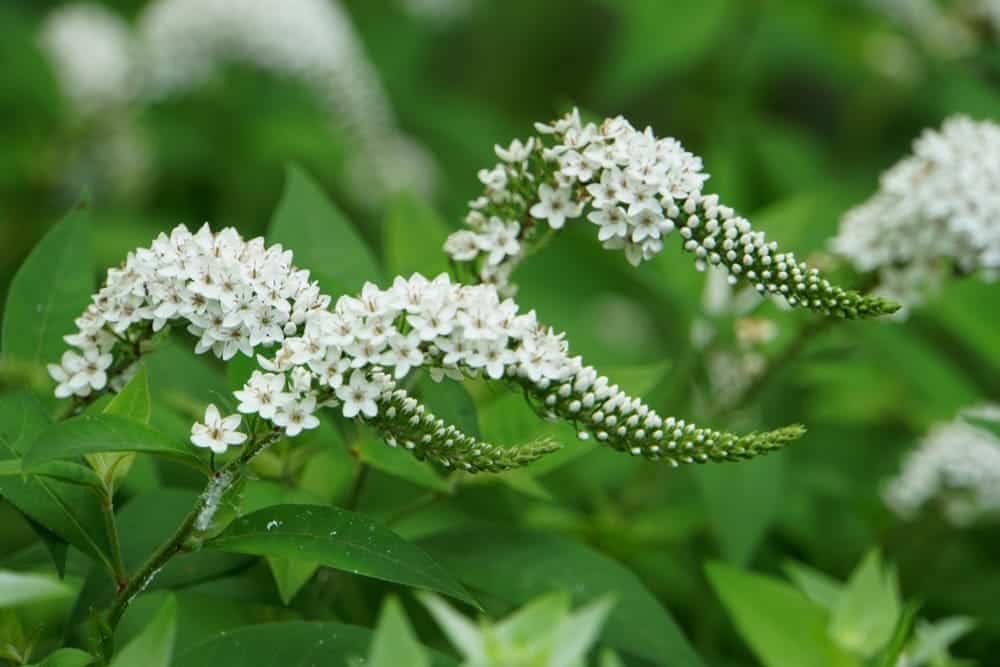Gooseneck loosestrife is an easy-to-grow herbaceous perennial with tall, elegant flowers.
A showy cluster of tiny white flowers bloom continually from July to September in zones 3-8. This plant will tolerate part sun and dry soil, but will grow best and spread in a sunny, moist area such as alongside creeks and ponds. Gooseneck loosestrife makes a stunning addition to wildflower gardens and cut flower bouquets.
Gooseneck Loosestrife Care and Growing Guide
1. Light
Gooseneck loosestrife is best suited to full sun – at least six hours of direct sunlight per day. It will tolerate part sun (three to six hours of sunlight per day) but the growth will be stunted and flower production will be lessened.
In certain growing areas, planting gooseneck loosestrife in part sun will help control the spread if desired. Decreasing the amount of sunlight, however, will result in leggy plants with fewer flowers.
2. Soil
Gooseneck loosestrife is a highly tolerant plant. It will survive in poor soil, but it prefers plenty of organic material or leaf litter mixed in with the soil. It grows especially well next to ponds, bogs, marshes, and streams. This adaptable plant will make itself at home in any garden.
3. Water
With frequent watering, gooseneck loosestrife will grow energetically and bloom into a profusion of white racemes in the late summer. This plant prefers consistently moist soil, but will tolerate somewhat drier soil or even occasional standing water. Maintain constant watering and rich, moist soil for ideal growth.
4. Zones
Gooseneck loosestrife is native to Asia where this wildflower grows near streams, but will grow enthusiastically in zones 3-8 in North America. After cutting back in the fall, this hardy perennial will survive the winter under a layer of mulch.
5. Height and Spread
Gooseneck Loosestrife is a towering plant reaching up to 36 inches in height. This upright plant adds dramatic height to any garden. It is excellent for borders and backgrounds. In ideal conditions, gooseneck loosestrife will grow aggressively and can spread about 3 feet. The flower stalks can grow quite tall and may need support. Allow at least 24-36” spacing when planting.

6. Companion Plants
Wildflower gardens will make an excellent home for beautiful gooseneck loosestrife flowers. It also makes a great border plant along buildings or fences. Its height makes it a good background plant in traditional flower beds. Other tall-growing plants, such as bee balm, will provide stunning contrast.
Prairies and marshes are perfect for this low maintenance plant. It will also grow happily next to ponds and alongside creeks. In shadier areas, gooseneck loosestrife can become leggy, so low-growing aggressive perennials make good companions.
7. Speed of Growth
Gooseneck loosestrife is a fast-growing herbaceous plant well known for its spreading habit. Left unchecked in its ideal conditions, it will quickly overtake neighboring plants and flowers. Controlling the growth by planting in part-shade and reducing waterings is effective, but may result in fewer flowers.
Gooseneck loosestrife does not normally spread by seeds, but by a system of rhizomes underground. To keep the plant healthy and controlled, the rhizomes should be divided frequently. Gooseneck loosestrife is not to be confused with purple loosestrife, which is an invasive species in North America.
8. Flowers and Leaves
Low growing and long blooming, the profusion of pointed leaves make the gooseneck loosestrife an excellent groundcover plant. Mid-summer, several tall sturdy spikes of flowers appear in the middle of the plant. The large clusters of tiny flowers are white. Although they have no scent, the flowers will attract butterflies.
The curved stem of the raceme gives the plant its distinctive name. The cluster of flowers will bloom from July to September and will lengthen as the summer goes on. Each raceme can reach up to a foot in length and is prized by florists to add height to cut flower bouquets.
The foliage of the gooseneck loosestrife turns a stunning golden orange in the autumn, adding drama and interest to a late summer, early fall garden.
9. Container Plants
Gooseneck loosestrife can be propagated in containers, but it is not recommended to be grown as a container plant. To propagate gooseneck loosestrife, simply plant the divided rhizomes in a well-drained container of potting soil and water frequently. Avoid overwatering until the plant is fully established.
The plant may then be replanted into the garden. Seeds may also be harvested from the flowers after the blossoms fade in the autumn. Propagating seeds in pots is the same process for growing gooseneck loosestrife from divided rhizomes.
10. Pruning and Dividing
After the flower stalks fade in the autumn, they should be cut back for aesthetic purposes. Cut back the entire plant in the winter down to two inches above the soil. Protect the crown by covering with a light layer of mulch in the winter.
The plant will regrow from the crown in the spring. Every two to three years, divide the plant in the fall or the spring by digging up and removing up to one third of the rhizomes.
The removed rhizomes can be replanted elsewhere, propagated in pots, or discarded. Frequent dividing will keep the spread of the plant under control, prevent overcrowding, and will keep the plant healthy and productive.
11. Fertilizer
Fertilizer is not necessary for a fast-growing plant such as the gooseneck loosestrife, but fertilizer may encourage it to bloom in poor soil or in shady areas. Apply a 10-10-10 balanced fertilizer in the early spring.
12. Common Diseases
Gooseneck loosestrife is not especially susceptible to disease or pests. It will withstand extreme temperatures and frost. Since it is a water-loving plant, it is possible that rust can appear on the leaves. Snails and slugs may also be an issue. Reducing watering will dry out the plant and decrease the risk of fungus.
Conclusion
Gooseneck loosestrife makes an excellent border plant or addition to a wildflower garden. It requires very little maintenance once established and can easily overtake other plants if not controlled. Beginner gardeners will reap the rewards of months of long-blooming flowers and striking golden leaves in the fall. Moist soil and full sun will encourage gooseneck loosestrife to produce a profusion of white flowers atop tall stalks.
Victoria is the owner and main author of hobby plants. She loves spending her free time in her garden planting and taking care of her plants. Victoria hopes you enjoy the content here!




![Mother Of Thousands Plant [Complete Plant Care Guide] Mother Of Thousands Plant [Complete Plant Care Guide]](https://www.hobbyplants.com/wp-content/uploads/2022/07/mother-of-thousands-plant-300x158.jpg)
![How Often Should You Water Pothos? [Complete Care Guide] How Often Should You Water Pothos? [Complete Care Guide]](https://www.hobbyplants.com/wp-content/uploads/2022/07/how-often-to-water-pothos-300x158.jpg)
![Can Snake Plants Live Outside? [COMPLETE CARE GUIDE] Can Snake Plants Live Outside? [COMPLETE CARE GUIDE]](https://www.hobbyplants.com/wp-content/uploads/2022/08/can-snake-plants-live-outside-300x158.jpg)
![Majesty Palm Plant Care: [Complete Beginner's Guide] Majesty Palm Plant Care: [Complete Beginner's Guide]](https://www.hobbyplants.com/wp-content/uploads/2022/08/majesty-palm-care-300x158.jpg)
![Exotic Angel Plant Care: [Complete Beginner's Guide] Exotic Angel Plant Care: [Complete Beginner's Guide]](https://www.hobbyplants.com/wp-content/uploads/2022/08/exotic-angel-plant-care-300x158.jpg)
![Do Coleus Like Sun Or Shade: [Complete Care Guide] Do Coleus Like Sun Or Shade: [Complete Care Guide]](https://www.hobbyplants.com/wp-content/uploads/2022/08/coleus-sun-or-shade-300x158.jpg)
![Snow White Waffle Plant: [Complete Care Guide] Snow White Waffle Plant: [Complete Care Guide]](https://www.hobbyplants.com/wp-content/uploads/2022/08/snow-white-waffle-plant-300x158.jpg)
![Waffle Plant Care: [Complete Beginner's Guide] Waffle Plant Care: [Complete Beginner's Guide]](https://www.hobbyplants.com/wp-content/uploads/2022/08/waffle-plant-300x158.jpg)